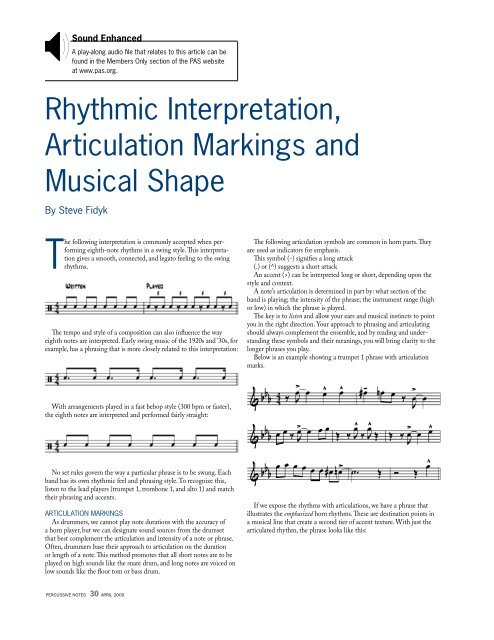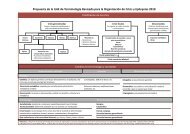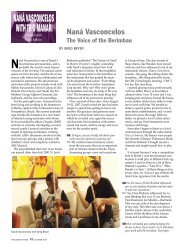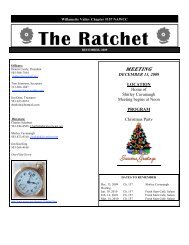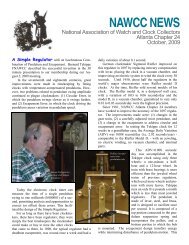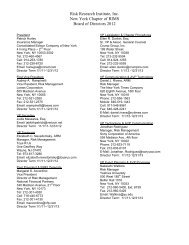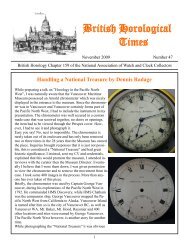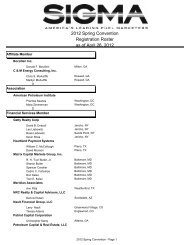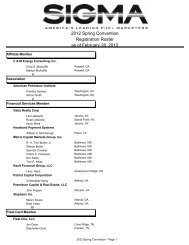Sound, Time, & Creativity - S.F.
Sound, Time, & Creativity - S.F.
Sound, Time, & Creativity - S.F.
You also want an ePaper? Increase the reach of your titles
YUMPU automatically turns print PDFs into web optimized ePapers that Google loves.
<strong>Sound</strong> Enhanced<br />
A play-along audio file that relates to this article can be<br />
found in the Members Only section of the PAS website<br />
at www.pas.org.<br />
Rhythmic Interpretation,<br />
Articulation Markings and<br />
Musical Shape<br />
By Steve Fidyk<br />
The following interpretation is commonly accepted when performing<br />
eighth-note rhythms in a swing style. �is interpretation<br />
gives a smooth, connected, and legato feeling to the swing<br />
rhythms.<br />
�e tempo and style of a composition can also influence the way<br />
eighth notes are interpreted. Early swing music of the 1920s and ’30s, for<br />
example, has a phrasing that is more closely related to this interpretation:<br />
With arrangements played in a fast bebop style (300 bpm or faster),<br />
the eighth notes are interpreted and performed fairly straight:<br />
No set rules govern the way a particular phrase is to be swung. Each<br />
band has its own rhythmic feel and phrasing style. To recognize this,<br />
listen to the lead players (trumpet 1, trombone 1, and alto 1) and match<br />
their phrasing and accents.<br />
ARTICULATION MARKINGS<br />
As drummers, we cannot play note durations with the accuracy of<br />
a horn player, but we can designate sound sources from the drumset<br />
that best complement the articulation and intensity of a note or phrase.<br />
Often, drummers base their approach to articulation on the duration<br />
or length of a note. �is method promotes that all short notes are to be<br />
played on high sounds like the snare drum, and long notes are voiced on<br />
low sounds like the floor tom or bass drum.<br />
PERCUSSIVE NOTES 30 APRIL 2009<br />
�e following articulation symbols are common in horn parts. �ey<br />
are used as indicators for emphasis.<br />
�is symbol (-) signifies a long attack<br />
(.) or (^) suggests a short attack<br />
An accent (>) can be interpreted long or short, depending upon the<br />
style and context.<br />
A note’s articulation is determined in part by: what section of the<br />
band is playing; the intensity of the phrase; the instrument range (high<br />
or low) in which the phrase is played.<br />
�e key is to listen and allow your ears and musical instincts to point<br />
you in the right direction. Your approach to phrasing and articulating<br />
should always complement the ensemble, and by reading and understanding<br />
these symbols and their meanings, you will bring clarity to the<br />
longer phrases you play.<br />
Below is an example showing a trumpet 1 phrase with articulation<br />
marks.<br />
If we expose the rhythms with articulations, we have a phrase that<br />
illustrates the emphasized horn rhythms. �ese are destination points in<br />
a musical line that create a second tier of accent texture. With just the<br />
articulated rhythm, the phrase looks like this:


